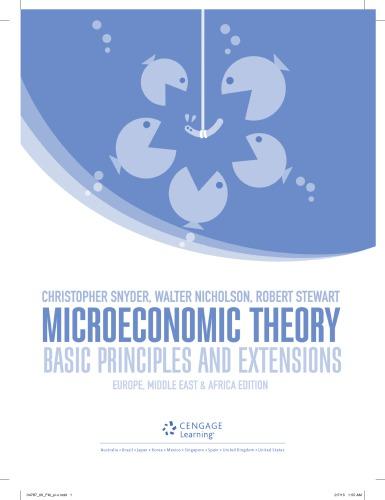2.12 Proof of the envelope theorem in constrained optimisation problems Because we use the envelope theorem in
Question:
2.12 Proof of the envelope theorem in constrained optimisation problems Because we use the envelope theorem in constrained optim isation problems often in the text, proving this theorem in a simple case may help develop some intuition. Thus, sup pose we wish to maximise a function of two variables and that the value of this function also depends on a parameter, a: f (x1, x2, a). This maximisation problem is subject to a constraint that can be written as: g(x1, x2,
a) = 0.
a.
Write out the Lagrangian expression and the irst order conditions for this problem.
b.
c.
d.
e.
f.
g.
Sum the two irst-order conditions involving the x’s.
Now differentiate the above sum with respect to a — this shows how the x’s must change as a changes while requiring that the irst-order conditions continue to hold.
As we showed in the chapter, both the objective function and the constraint in this problem can be stated as functions of a: f (x1(a), x2(a), a), g (x1(a), x2(a),
a) = 0. Differentiate the irst of these with respect to
a. This shows how the value of the objective changes as a changes while keeping the x’s at their optimal values. You should have terms that involve the x’s and a single term in �f/�a.
Now differentiate the constraint as formulated in part
(d) with respect to
a. You should have terms in the x’s and a single term in �g/�a.
Multiply the results from part
(e) by λ (the Lagrange multiplier), and use this together with the irst-order conditions from part
(c) to substitute into the derivative from part (d). You should be able to show that df
(x1(a), x2(a), a)
da
= �f
�a + λ�g
�a , which is just the partial derivative of the Lagrangian expression when all the x’s are at their optimal values. This proves the envelope theorem.
Explain intuitively how the various parts of this proof impose the condition that the x’s are con stantly being adjusted to be at their optimal values.
Return to Example 2.8 and explain how the envelope theorem can be applied to changes in the fence perimeter P – that is, how do changes in P affect the size of the area that can be fenced?
Show that in this case the envelope theorem illustrates how the Lagrange multiplier puts a value on the constraint.
Step by Step Answer:

Microeconomic Theory Basic Principles And Extensions
ISBN: 9781473729483
1st Edition
Authors: Christopher M Snyder, Walter Nicholson, Robert B Stewart






